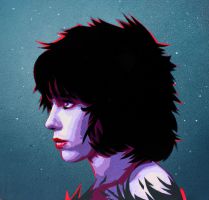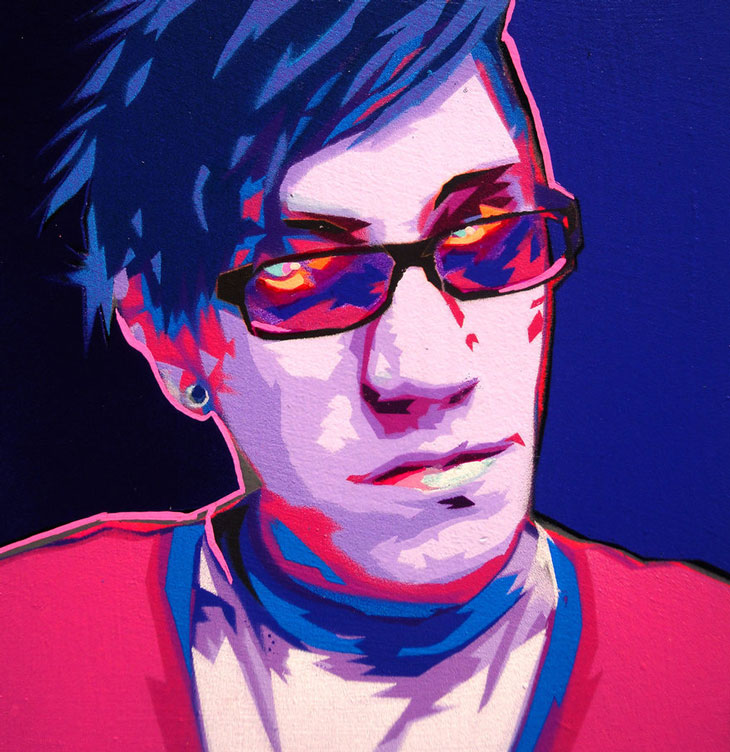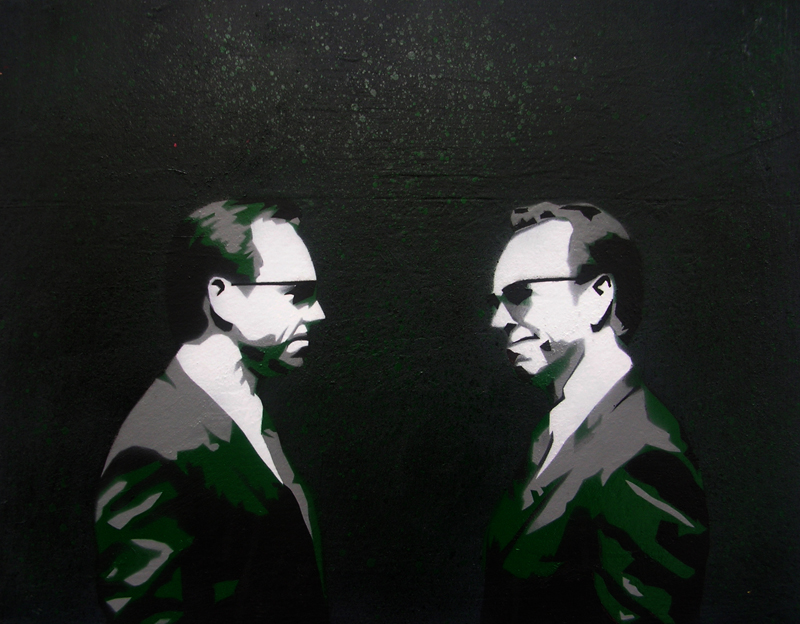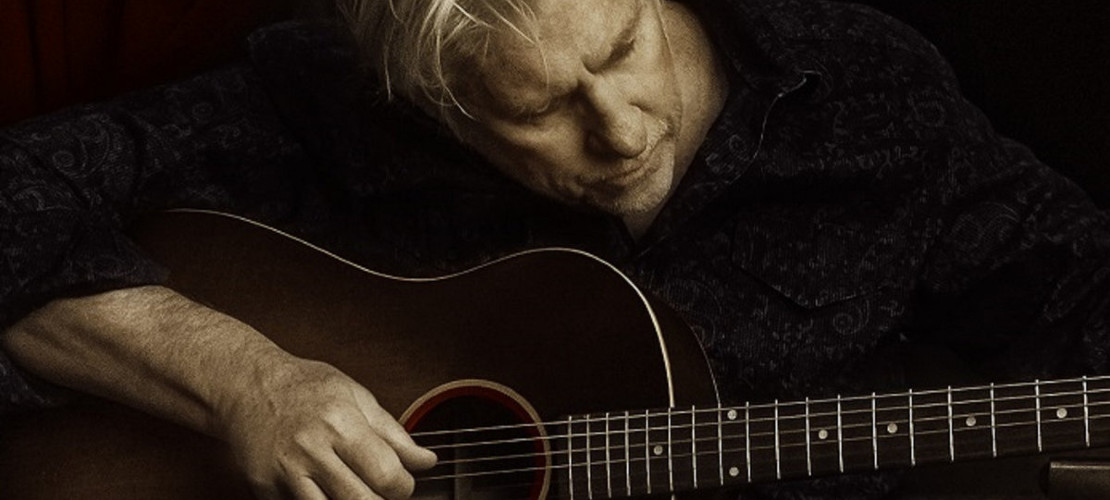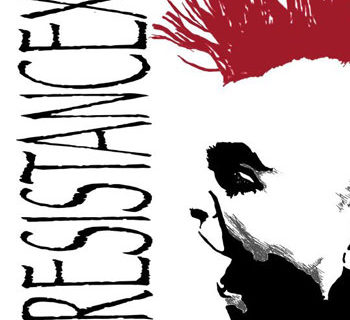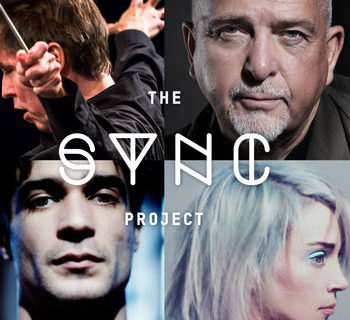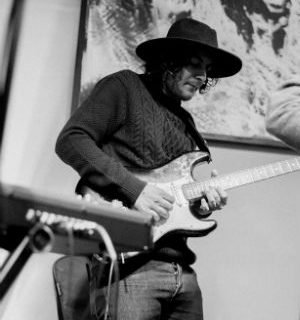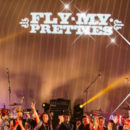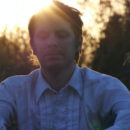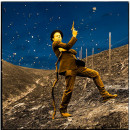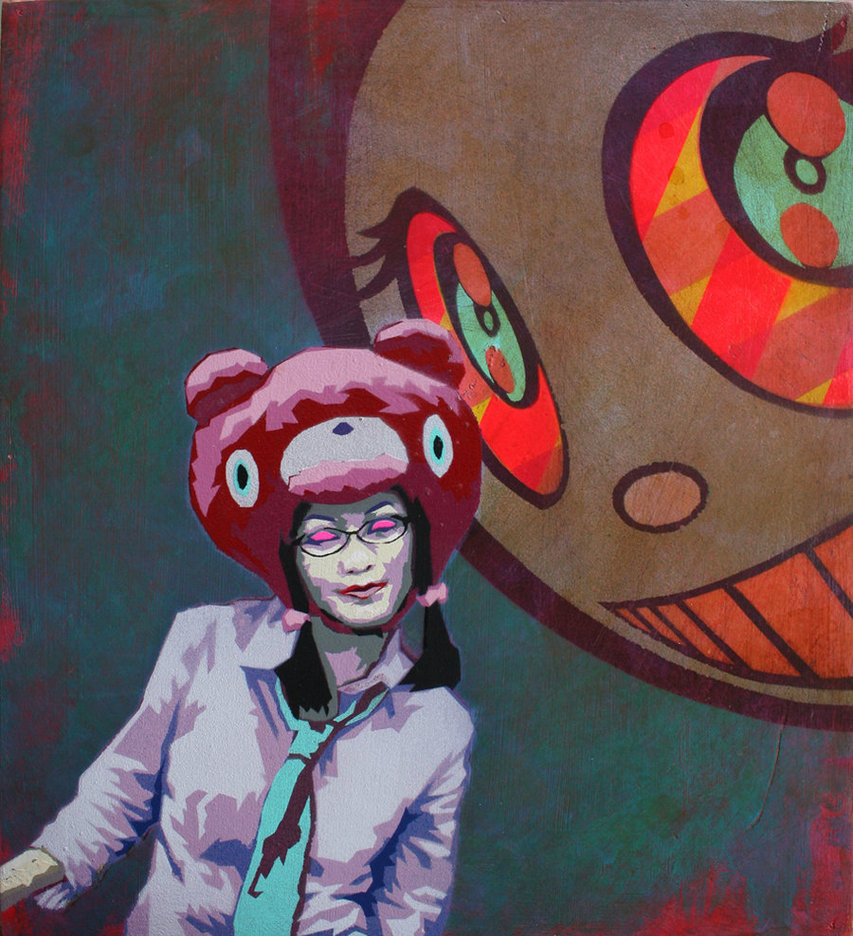
Takeshi Speed Crunk - Aerosol stencil on board. "I love Japanese Cosplay and Harijuku fashion, it sorta matches my crazy colour ethic and my need to mash things up, here there is a bit of Murakami and Gloomy Bear."
“Draw, photograph, extrapolate, composite, stitch, review, redraw, refine, make a mess, embrace disaster - even when you are unsure - something always gives.”
When I was kid, there was a guy with a hustle that seemed so...ballsy. A friend of my older sisters, with long, dirty blond surfer hair, probably 17 or 18 and extremely likable, he laughed excitedly each time he told me about it. I got the impression he was surprised it worked so consistently and perfectly every time.
He painted the house numbers on the curbs in all the local neighborhoods. Rows upon rows of tract houses, mile after suburban mile, almost the same except for the numbers on the front and on the curb. He didn’t ask. He just painted them. He had a stencil set with all the numbers and aerosol cans of white paint that he kept in a wooden crate with a handle and wheels. There was a metal jig into which he slid the numbers to keep them straight. A few quick bursts of spray onto the stencil and done. His hands were permanently stained white.
After finishing a street, he would knock on each door, explain how he was saving up for college, and grandly wave his arm to show the entire street’s curbs gleaming white on both sides in the Californian sun. He would tell them they were in no way obligated to pay, but a small donation would help cover the paint and his time. Seeing the freshly painted numbers and a teenager with chutzpah, drive, and an entrepreneurial fire in his soul, the owner couldn’t help but break out the wallet. He made a few hundred every weekend.
That’s how I was introduced to the stencil; it was benign, unthreatening, and slightly boring, but in the right hands, it sure worked for stacking some fat skrill. In time, graffiti artists discovered this humble little device and changed street art forever. The works of Blek la Rat, Shepard Fairey, and Banksy command thousands and sometimes millions of dollars. That humble stencil I saw in the kid’s wooden crate has come a long way.
Kiran X, an aerosol stencil illustrator and designer from New Zealand, is “fascinated with the line between precision and chaos in art making.” Like a lesus naturae, he hammers graphics into visceral creations that are both “sinister and seductive.”
Meet KIRAN X
How did the opening of your show “At The Push of a Button” go, and how many pieces are in it?
It was a really great show. I have a total of eight pieces and one work directly to wall. Earlier that day I had a tooth pulled out and the pain was coming in waves, so I decided to go back to the gallery to touch up my wall piece. The day before I worked on it all day and couldn’t really see it for what it was till the next morning - uncertainty. By the time of the opening night I was on a high, delirious from pain and extremely satisfied I came in that morning. I was drooling from the numbness in my mouth most of the night.
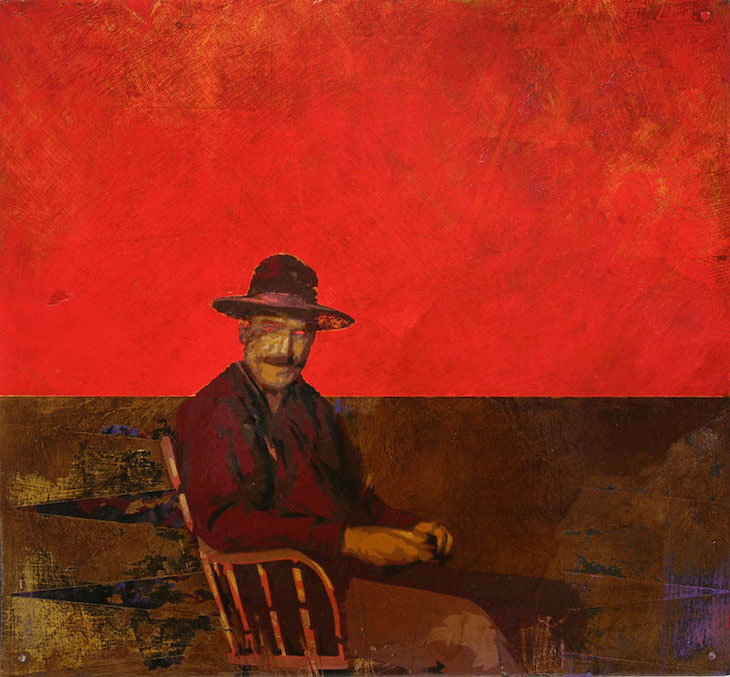
Daniel Plainview- "This is about the land - wasteland and weatherworn and the effects it has on humans - can it transform us, can it drive us mad."
How big is the original artwork and is it on canvas?
The large work is directly on to the gallery wall. It’s about 2.5 meters square. Canvas isn’t really for me because it doesn’t reflect the texture or surface of the urban environment. I tend to paint on found surfaces, rusty metal, and construction site plywood. Found surfaces have a history of marks and grime that I often like to work with. It kinda tells you what to paint on it.
Have you ever sprayed on buildings?
I have for commission work for small non-profit organizations who are after 'edgy' sprayed logos, and I have done characters during my early stencil years. With stenciling, the process of it defines the environment in which you create it. I’m quite technical and I work in layers so the zone of a studio is best suited to me. I'm fortunate to live in a city where the walls are vibrant and have the galleries to match, and most people in the public catch on very quickly who we are because the community is so close (it's hard to stay illegal for too long!).
American openings have wine and cheese, what do New Zealand openings have?
Oh yeah, we have that! Each gallery is different, our lowbrow galleries will focus on the beers and pretzels whereas the institutions will have the all-out catering. The gallery in which this exhibition takes place is quite different, it has a mix of high-profile and experimental exhibitions as well as grassroots, community-level initiatives. One of the aims of this exhibition was to call out to the skilled youths of this part of town who may also be at risk socially. So although there was catering here, it never at any point felt exclusive or overdressed.
Speaking of which, you live and work in New Zealand. Most Westerners would consider it the end of the earth; how does that inform or influence your work?
I think it does because it makes us (me) want to connect more with others, to learn about other artists’ processes and perspectives. A healthy activity is to travel and collaborate with overseas artists and share cultures – I think people in 'power' have a lot to learn from us. Though the truth is we match artists the world over; maybe it’s travel or through social media, but I feel connected to a global stencil community, because we speak the same aerosol visual language, so yeah, not one bit isolated. What I like is when I discover someone who is doing similar work on the other side of the world – somehow our paths, despite different backgrounds, lead us to paint similar icons. I just think that's awesome.
Is your work entirely stencil these days?
I used to be all 'stencil purist’ in my earlier years, just to make a point that I'm dedicated to it, but I now mix it up because there are so many awesome art tools to use. It's all primarily aerosol stencil, but I'll work into it with paint and pens – I absolutely love to draw. The larger works I create are all aerosol, I just want people to get a massive hit and smell of the aerosol without the distractions of other media.
What common misconception, if any, do people have about stencil artists?
Yeah there is. When you bring sheets of stencils to a paint jam, there's the assumption that it's all going to be easy or you are taking short cuts – I had one spectator assume this. I told him I had to actually hand cut 20 sheets of two-meter square pieces of plastic, which took a week before I got here. People don't necessarily see the weeks of planning that goes into a work, so I've dedicated myself to showing people everything I do through production diaries! Stenciling is a bit of paradox in the aerosol world, it's very tight and requires a lot of planning, process, and printing work as opposed to freestyle and the often intuitive form and flair of freehand painting. Plus, sticking stencils up a wall with tape doesn't look as sexy, I wish it did! That’s why you have to make sure without a doubt that the image you put up will kick ass. I've been in a few scenarios where I am the only stencil guy lugging around plastic sheets to a spray competition, but I have never regretted it.
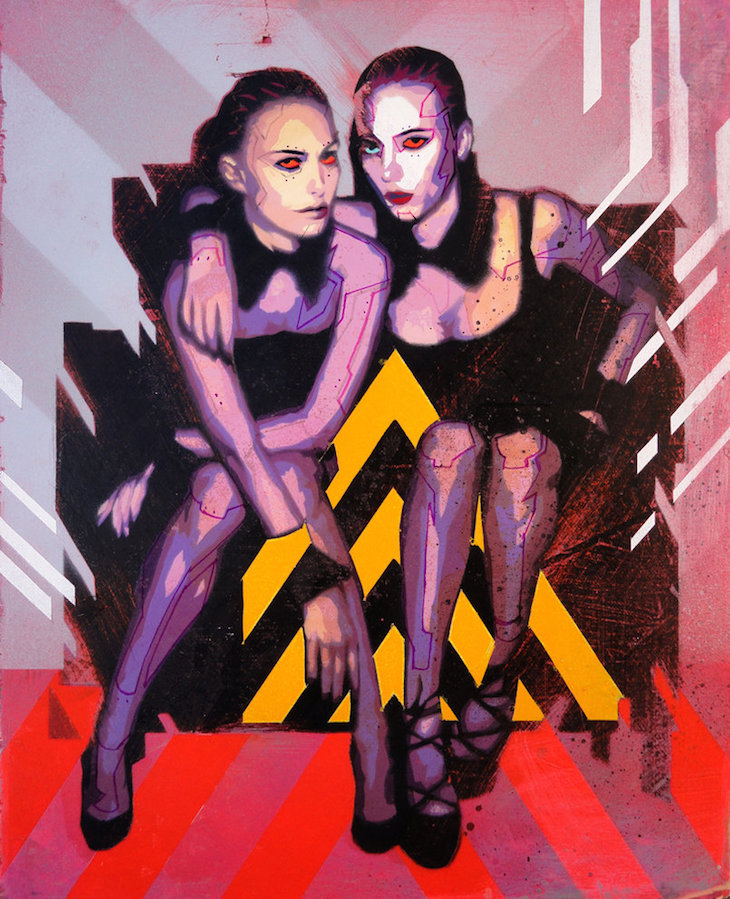
Fury 161 and Fiorina-Aerosol stencil on found reinforced timber. From the SEDUCTIVE MECHANIZM collection.
From an artistic standpoint, who have been your biggest influences?
I’m a massive fan of Mad C. Her’s color selection, dedication to wild style, and its history and her many adaptive styles from abstract to photorealist. She seems fearless, has a massive track record, and reminds me every time how cool it is to be using an aerosol can. My other faves are SABRE, tattoo artist Alex Sorsa, and the large scale faces of RONE. That’s only some of the many I adore.
The stencils themselves are super detailed with many cuts. This looks like it adds depth and increases the overall texture of the piece, in addition to making the piece pop with color. How did this process come about, trial and error?
Stencils are originally a designer’s medium to create patterns and signs that communicate as effectively as possible. In time us artists have hijacked for our own means – to subvert politics, to create humor stencils, to hijack symbols of authority. With aerosol technology getting better, it also became about the exploration of style, which is where I sit. I just want to make people's eyes dance. I saw the potential in stencil over 10 years ago, and decided then and there that I was gonna push it as far as it can go. I've made 3D stencils, light stencils, glow in the dark, and even tapestry stencils! I’m formally trained and I teach art but I can proudly say that I’m a self-taught aerosol stencilist. What I love about the process is that I get to utilize drawing, photography, and digital manipulation before I even begin the cut. I enjoy the rush of creating a precision line that flirts with disaster. The process also suits my obsessive need to dissect and reconstruct a puzzle – which is what layered stencils are to me. Plastic surgery comes to mind!
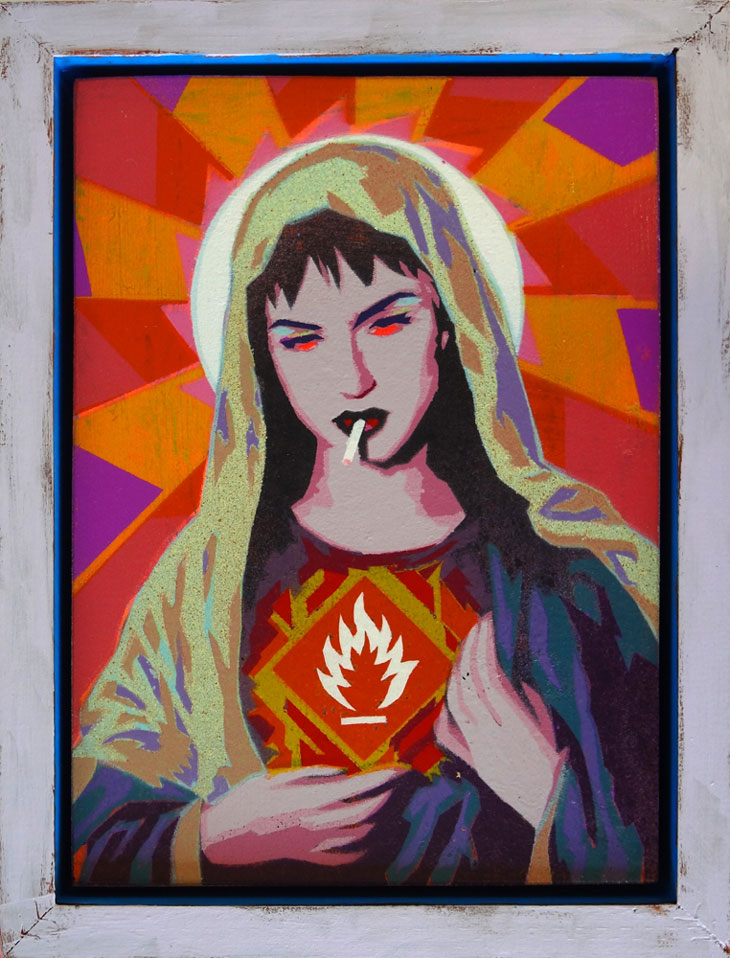
Fuel Injection-Aerosol stencil on board. "This is a 3rd generation appropriation, originally copied and changed from a generic Sacred Heart of Mary image by pop singer Madonna in the 80's, was associated with controversy. I was taken by that image and decided on replacing the burning heart for a flammable symbol. This is a much smaller stencil but was trickier to do than it looks! Aerosol stencil on board."
Icons of popular culture seem to be a common theme. What attracts you to this subject matter?
Plain and simple, I'm a geek. I love all things pop. As a kid I would get excited about Transformers, amongst other material, and I would always respond by drawing them and sharing my drawings with my friends. Nothing has changed, I'm a dad now and I am even more enthusiastic about this stuff than I ever was, and I still paint it and share. I just have better tools to play with. Years ago on a visit to Calcutta, I remember driving through the countryside and seeing enormous decayed billboards of cosmetic models. It was too expensive to take down so they would stay up and decay – I thought they looked like fallen urban goddesses. It was beautiful imagery that dictates the mechanized portrait themes that I continue to explore here.
When Kiran is not being a professional geek, he is an art tutor at The Learning Connexion and a Support Worker at Community Connections. He has over 12 years of lecturing experience at Tertiary Creative Technologies, where he has specialized in the areas of critical studies and studio practices. His works have been widely exhibited, reviewed, and published in New Zealand, Australia, Germany, and Japan.

